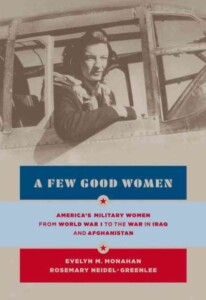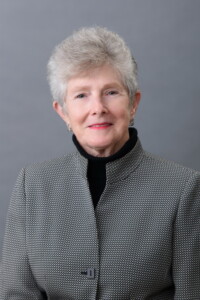How to Stay Busy in Retirement: Local Veteran and Retired Nurse Carolyn Nagy ‘Does Something About It’
Posted on May 13, 2025
by Lindsay W.
Carolyn Nagy is no stranger to tackling difficult problems. In Saudi Arabia as the Assistant Chief Nurse during Operation Desert Storm, she oversaw and coordinated the care of wounded soldiers until they could be returned to duty (usually within 72 hours) or evacuated to more extensively equipped facilities. She was also on the team responsible for designing the hospital. “I’d never set up a 400-bed hospital before. They gave us a small plot of land for the hospital and living quarters. It was our job to make it fit and work.”
Though she hadn’t before set up a hospital, nor ran a nonprofit support program at the time that United States Vets Inc. asked her to head the Women Veterans Initiative (WVI), Carolyn possesses a certain stick-to-it-iveness that gets the job done. “United States Vets, Inc. is a small local nonprofit working with all veterans, and they recognized a gap in services related to the needs of women veterans,” Carolyn explained.
“I think I’m able to help people because I can be flexible and adaptable with only the most basic of information. I see a need and I think well, here’s what I’m going to do about it.” It’s that deep need to do something about it that’s led Carolyn to keep helping people even after retirement (or retirements!) through WVI.
Carolyn Nagy’s first career shift occurred in 1992. She served in the Army Nurse Corps from 1980 until 1992 when she was honorably discharged with the rank of Major. For her service in Desert Storm she received the Army Commendation Medal, Certificate of Achievement for Humanitarian Services, and a Letter of Commendation.
About her beginnings in the nursing career and military she shared, “I was a civilian nurse first, before ever joining the military. (In fact, I recall my dad saying, ‘No daughter of mine is going to join the service!’) There were only so many jobs for women at the time, and a nurse was one of them.
Then, I was somewhere and overheard a conversation that sounded interesting. It turned out that a military recruiter was next to me, and I’m a curious person so I started asking questions. Fast forward and I’m not sure whether it’s my own problem with saying no or a subconscious desire to prove to my father I could do it, but I signed up for the Army.”
After a very accomplished tenure in the military, Carolyn resumed her civilian nursing career focusing in the areas of cardiology, emergency room, and trauma. She retired from the Mercy Health Care system after many years of service.
Retirement number two was from Stautzenberger College, where Carolyn developed the Practical Nurse Program and served as the program’s director until retiring for the final time in 2015.
While Carolyn may now truly be ‘retired,’ she’s certainly very busy.
The program she now runs in a volunteer capacity, the Women Veterans Initiative, focuses on four areas of service: resources, advocacy, education, and referrals. The resources are often simple, yet are vital and immediate needs such as food, clothing, and linens. Though its budget is limited, WVI is able to assist with items the veteran relies on daily such as rent, phone bills, utilities, and car repair. These are often urgent situations, so we do everything we can to de-escalate and ease those financial burdens within 24-48 hours.
WVI also helps veterans advocate for themselves. For example, Carolyn worked with a woman who had a traumatic brain injury. Carolyn would speak up with and for the veteran in appointments so she could get the help she needed. Carolyn knows that education is important for independence, and thus refers veterans to United States Vets, Inc. where they may apply for assistance with personal expenses while pursuing higher education. The education fund is distributed annually to one veteran who meets the established criteria (see criteria and application here). The monies received do not conflict with scholarship or grant funding.
“A success story for our organization is when a woman veteran is able to maintain a safe and healthy environment. We aim to keep them independent,” explained Carolyn. She is dedicated to following up with those she serves, performing status checks within the three months after that initial interaction and calling the women even a year later to ask how they are doing and if they need more help.
These check-ins are often a much needed interaction, as many of the women served by the Initiative do not have strong support networks. It can be difficult for women veterans to find community. “It’s not like we all wear a hat that says ‘veteran’,” Carolyn explained. “For some, their husband won’t allow them to tell people they were in the service. For others, they minimize their position. For example, if a woman was a cook she may be reticent to say she served, but in truth everyone is a soldier first and their contributions mean something.”
Carolyn shared that there are over 2,000 women veterans in our area, but partially because of this hesitancy to self-identify they can be difficult to reach. The WVI is currently connecting about 300 individuals, but would like to serve more. “Part of it is about finding community. It’s important for these women to meet others with shared experiences who they can talk to.”
In addition to having a tough time finding community post-service, Carolyn shared that finding female counselors or all female groups even while enlisted proves difficult and this causes many women to remain silent. “Women have a uniquely difficult time in the military, because it’s a system that often doesn’t consider their needs. Some things have improved, for example as the number of single mothers enlisting has increased you see more available women’s health clinics with better security and separate entrances. But many systems are still tough to navigate… how do you change a tampon in a battle tank with no bathroom?”
Gear and logistics made for men can be oversized and cumbersome. The weight of military backpacks has been known to cause stress fractures in women, and kevlar vests that don’t fit the female form pose safety risks. “In Desert Storm we had so much gear on and you’re in the middle of the sweltering sand,” Carolyn recalled when traveling in a convoy across Saudi Arabia how difficult it was to stop along the road side, remove gear (weighing around 60 – 100 pounds for combat unit members) and squat to relieve themselves. According to the author of Invisible Women, it would take until 2011—or 35 years after women were first admitted to U.S. military academies—that the first uniform design to account for women’s hips and breasts was developed.
Navigating mismatched systems takes a psychological toll all its own, but the prevalence of sexual harassment and violence compounds into a very negative experience. One in three women experience MST (Military Sexual Trauma) while enlisted, with one in sixteen having been a victim of rape or other sexual assault. “The women I reach out to via the Initiative who have been sexually abused have the most serious problems. PTSD, depression, and other long-term results affect their everyday, from concentrating to keeping jobs to parenting.”
When asked what more Carolyn wished the general public knew about veterans, she shared that most people are not aware that benefits from veteran to veteran are not always the same. “There are priority groups based on income. Because of being in a medical profession at the time of retirement, I’m in a group that receives lesser benefits based solely on income. It also depends on when you served. Those who served in ‘gap years’ or not during wartime will receive less benefits than soldiers who served during wartime—even if only one day of their service took place during a conflict.” Essentially, not every veteran is actually receiving the help one might think they are so organizations like WVI are necessary to fill these gaps.
Though the work Carolyn does can at times create a lot to process, she’s set up strong boundaries and systems to combat burnout. For fellow nonprofit professionals she recommends listening for only that essential info needed to deliver services, and taking a day off. “Sundays are my own time.” She also advocates those working in public service to prioritize time for their hobbies. Some of hers include pickleball, reading, and photography. In addition to hobbies, she notes nonprofit workers must also prioritize themselves. “I’m at the top of my care list. If I don’t care for myself, I’ll be on empty and can’t care for anybody else.” Lastly, she advises to develop a support system sharing that a few ‘good lady friends’ can work wonders.
For family and friends of veterans, she urges them to encourage their veteran loved one to talk about their time in the service. “You need to be willing to be supportive of changes in behaviors and activity, understand that for a time your loved one’s life looked very, very different than it does at home.”
For those looking to help veterans, here are the ways Carolyn recommends connecting with WVI by subscribing to the Women Veterans Initiative email newsletter to stay updated on events, volunteer opportunities, and to read veteran stories (the newsletter is one way of preserving their history and acknowledging their good work).
“We do a summer picnic and a holiday party, and also provide food aid and holiday gifts. One really fun and unique event we had was in partnership with Little Blessings in Temperance, Mich. where our veterans got to meet the organization’s horses and have photos taken with them. There was an activity where you looked at horses and figured out which one represented you. Maybe it was the pack leader, or maybe the horse seemed a bit downtrodden. It really helped the women identify where they themselves were mentally, and who around them might offer some encouragement.” Carolyn also spoke very highly of a recent Mother’s Day photoshoot where participants could have their makeup done. “Something really special about the events is the women veterans will connect with each other without my intervention. They’ll build community on their own and keep in touch with one another.”
To get involved, connect with Carolyn Nagy and the Women Veterans Initiative at 419-893-5491 or cenagy@bex.net. Learn more about WVI via their website unitedstatesvets.org/women-veterans-initiative/ and follow the Initiative on Facebook.
To learn more about women veterans’ experiences, Carolyn recommends reading A Few Good Women: America’s Military Women From World War I to the War in Iraq and Afghanistan by Evelyn Monahan.

To learn more nonprofit resources and services available via Toledo Library, connect with our Small Business and Nonprofit team at business@toledolibrary.org or toledolibrary.org/sbn/.
Did you like this blog post? Keep up to date with all of our posts by subscribing to the Library’s newsletters!
Keep your reading list updated with our book lists. Our staff love to read and they’ll give you the scoop on new tv-series inspired titles, hobbies, educational resources, pop culture, current events, and more!
Looking for more great titles? Get personalized recommendations from our librarians with this simple form.


